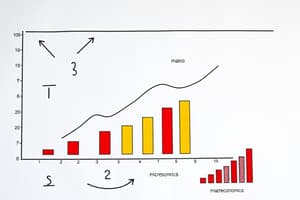Podcast
Questions and Answers
What is the primary focus of microeconomics?
What is the primary focus of microeconomics?
- The economy as a whole
- National inflation rates
- Individual consumers and businesses (correct)
- Global trade patterns
What does the Law of Demand state?
What does the Law of Demand state?
- Price and quantity supplied are directly related
- Price decreases lead to increased quantity demanded (correct)
- Higher incomes reduce demand for goods
- Demand is always equal to supply
Which economic system relies heavily on government intervention?
Which economic system relies heavily on government intervention?
- Command Economy (correct)
- Market Economy
- Free Market
- Mixed Economy
What is Gross Domestic Product (GDP)?
What is Gross Domestic Product (GDP)?
Which market structure is characterized by a single firm controlling the entire market?
Which market structure is characterized by a single firm controlling the entire market?
What is the main purpose of fiscal policy?
What is the main purpose of fiscal policy?
What does the concept of comparative advantage refer to?
What does the concept of comparative advantage refer to?
What does the unemployment rate measure?
What does the unemployment rate measure?
Flashcards are hidden until you start studying
Study Notes
Key Concepts in Economics
1. Definitions
- Economics: The study of how individuals, businesses, and governments allocate scarce resources.
- Scarcity: The fundamental economic problem of having limited resources to meet unlimited wants.
2. Branches of Economics
- Microeconomics: Focuses on individual consumers and businesses; analyzes supply and demand, pricing, and consumer behavior.
- Macroeconomics: Studies the economy as a whole; looks at national income, inflation, unemployment, and economic growth.
3. Fundamental Principles
- Supply and Demand: Determines price levels in a market.
- Law of Demand: As price decreases, quantity demanded increases, and vice versa.
- Law of Supply: As price increases, quantity supplied increases, and vice versa.
- Opportunity Cost: The value of the next best alternative foregone when making a decision.
4. Economic Systems
- Market Economy: Decisions are driven by supply and demand; minimal government intervention.
- Command Economy: Central authority makes all economic decisions; resources are allocated by the government.
- Mixed Economy: Combines elements of market and command economies.
5. Key Economic Indicators
- Gross Domestic Product (GDP): Total value of all goods and services produced in a country over a specific time.
- Inflation Rate: The rate at which the general level of prices for goods and services rises, eroding purchasing power.
- Unemployment Rate: The percentage of the labor force that is jobless and actively seeking employment.
6. Market Structures
- Perfect Competition: Many firms, identical products, free entry and exit.
- Monopolistic Competition: Many firms, differentiated products, some market power.
- Oligopoly: Few firms dominate the market; can collude to set prices.
- Monopoly: A single firm controls the entire market; significant barriers to entry.
7. Fiscal and Monetary Policy
- Fiscal Policy: Government's use of spending and taxation to influence the economy.
- Monetary Policy: Central bank's management of the money supply and interest rates to control inflation and stabilize currency.
8. International Economics
- Trade: Exchange of goods and services across borders.
- Comparative Advantage: When a country can produce a good at a lower opportunity cost than another country.
- Exchange Rates: The value of one currency for the purpose of conversion to another.
9. Economic Theories
- Classical Economics: Emphasizes free markets and the idea that markets are always clear through supply and demand.
- Keynesian Economics: Advocates for active government intervention to manage economic cycles.
- Behavioral Economics: Studies the effects of psychological, cognitive, and emotional factors on economic decisions.
10. Current Issues in Economics
- Globalization: Increasing interdependence of economies worldwide.
- Income Inequality: The disparity in income distribution among individuals or groups within a society.
- Sustainability: Balancing economic growth with environmental protection and social equity.
Key Concepts in Economics
Definitions
- Economics examines the allocation of scarce resources by individuals, businesses, and governments.
- Scarcity represents the core economic dilemma of limited resources facing unlimited wants.
Branches of Economics
- Microeconomics analyzes individual consumer behaviors and business activities, particularly supply, demand, and pricing.
- Macroeconomics explores the overall economy, including national income, inflation rates, unemployment, and growth trends.
Fundamental Principles
- Supply and demand are central market mechanisms that dictate price levels.
- The Law of Demand indicates an inverse relationship between price and quantity demanded: as prices decrease, demand increases.
- The Law of Supply suggests a direct relationship: as prices rise, supply increases.
- Opportunity cost refers to the value of the next best alternative that is sacrificed in decision-making.
Economic Systems
- Market economies are characterized by decisions based on supply and demand with minimal government involvement.
- Command economies are centrally planned, with the government making all critical economic decisions.
- Mixed economies incorporate features of both market and command systems, balancing government intervention and market forces.
Key Economic Indicators
- Gross Domestic Product (GDP) measures the total dollar value of all goods and services produced within a country during a specified period.
- The inflation rate tracks the general rise in prices for goods and services, indicating the erosion of purchasing power.
- The unemployment rate reports the proportion of the labor force that is jobless and actively seeking work.
Market Structures
- Perfect competition involves numerous firms offering identical products, allowing free market entry and exit.
- Monopolistic competition features many firms selling differentiated products, granting them some market influence.
- Oligopoly comprises a few firms that dominate the market, potentially collaborating to control prices.
- Monopoly exists when a single company monopolizes the market, creating high barriers for new entrants.
Fiscal and Monetary Policy
- Fiscal policy refers to government strategies involving spending and taxation aimed at influencing economic activity.
- Monetary policy encompasses actions by the central bank to regulate the money supply and interest rates to stabilize the currency and control inflation.
International Economics
- Trade encompasses the exchange of goods and services between nations.
- Comparative advantage allows a country to produce a good more efficiently at a lower opportunity cost than others.
- Exchange rates determine the worth of one currency relative to another, influencing international trade dynamics.
Economic Theories
- Classical economics promotes the concept of free markets where supply and demand automatically balance.
- Keynesian economics advocates for proactive government involvement in managing economic fluctuations.
- Behavioral economics focuses on how psychological and emotional factors affect the economic choices people make.
Current Issues in Economics
- Globalization refers to the growing interconnectedness of global economies and their mutual dependencies.
- Income inequality highlights disparities in income distribution among different societal groups.
- Sustainability seeks to reconcile economic growth with environmental preservation and social fairness.
Studying That Suits You
Use AI to generate personalized quizzes and flashcards to suit your learning preferences.




